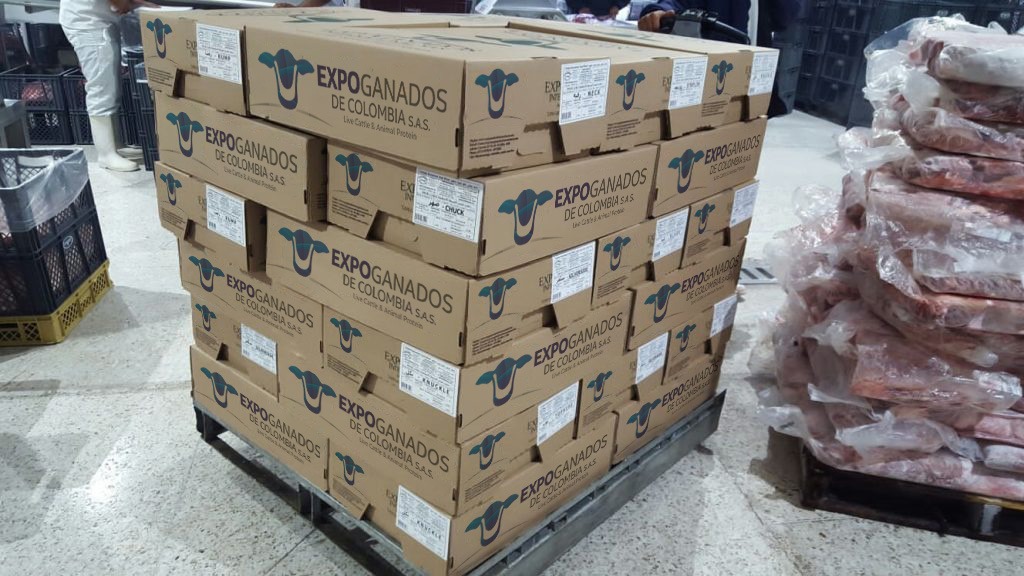Exporting Process
Livestock exports in Colombia play a fundamental role in the country's economy and the development of its agricultural industry. This activity has experienced significant growth in recent years and has generated multiple benefits for the livestock sector and the economy in general.
Livestock exports contribute directly to the increase of foreign exchange and the generation of employment in Colombia. Through exports to international markets, the country has obtained income that strengthens its balance of trade and contributes to the improvement of Colombian livestock, that is, of the nearly seven hundred thousand families that make up this sector.

In addition, this commercial activity generates employment throughout the entire production chain involved in the export activity: vaccinators, farm managers, veterinarians, and producers of corn silage, concentrated feed, sawdust, rice husks and hay, veterinarians, fuel pumps, seaports, hotel zone, financial/banking sector, tolls, transporters, administrative personnel; thus benefiting these thousands of workers throughout the country.
One of the key factors that has boosted cattle exports in Colombia is the quality of the cattle. The country has a sanitary status that allows it to carry out this commercial activity. The high standards of animal welfare and good livestock farming practices, which are carried out hand in hand with environmentally friendly and sustainable work, have also been recognized. They have also been recognized, which has contributed to positioning Colombian cattle as a reliable and quality option in international markets.
Livestock exports also promote the development of technology and innovation in the Colombian agricultural sector. To comply with international requirements and standards, livestock producers have had to implement improvements in their production systems, such as the adoption of assisted production technologies, improved animal genetics, and the implementation of traceability programs. These investments in innovation have increased the efficiency and competitiveness of the Colombian livestock sector.
In addition to the economic benefits, cattle exports in Colombia have a positive impact on the agricultural value chain and rural development. International demand for meat and live animals boosts livestock production at the national level, which in turn benefits local producers and rural communities. This activity contributes to income generation, the improvement of living conditions in the countryside, and the development of infrastructure and services in rural areas.


It is important to mention that the country's livestock herd must continue to grow, as well as the work being done to open new international markets through protocols with other countries, to expand the commercial field of action of the livestock activity.
In conclusion, cattle exports in Colombia play a crucial role in strengthening the economy and the development of the agricultural sector. In addition to the economic benefits, this activity drives innovation, promotes quality standards and animal welfare, and contributes to the country's rural development.
Cortes y Usos de la Carne
Neck and Chuck roast
Alternativas de Preparación
Uso principal: Estofar
Otros Usos: Moler
Otros nombres
Morrillo: Morro
Hip
Alternativas de Preparación
Uso principal: Freir
Otros Usos: Asar – Plancha
Otros nombres
Solomo extranjero, Caderita, Tetafula
Chuck Eye Roll Boneless
Alternativas de Preparación
Uso principal: Freír
Otros Usos: Asar – Hornear – Planchar
Otros nombres
Morrillo: Tablón – Muñeco
Top Sirloin
Alternativas de Preparación
Uso principal: Asar
Otros Usos: Asar – Plancha
Eye of Round
Alternativas de Preparación
Uso principal: Sudar – Hornear
Otros nombres
Capón, Bolito
Leg Center
Alternativas de Preparación
Uso principal: Freir
Otros Usos: Asar – Plancha
Otros nombres
Pulpa de pierna, Cesina
Bottom outside round flat
Alternativas de Preparación
Uso principal: Sudar
Otros Usos: Asar – Freir
Otros nombres
Posta. Herradero, Ampolleta, Atravezado
Knuckle Sirloin Tip
Alternativas de Preparación
Uso principal: Freir
Otros Usos: Asar – Plancha
Otros nombres
Bola negra, Huevo de aldana
Trip-tip
Alternativas de Preparación
Uso principal: Freir
Otros Usos: Asar – Sudar
Otros nombres
Colita extranjera
Strip Loin
Alternativas de Preparación
Uso principal: Asar
Otros Usos: Freir – Hornear – Plancha
Otros nombres
Chatas, Solomo, Lomo de caracha
Gooseneck
Alternativas de Preparación
Uso principal: Moler
Otros Usos: Sudar
Otros nombres
Morrillo: Murillo, Tabliado, Pepino, Marranito
Tenderloin
Alternativas de Preparación
Uso principal: Hornear
Otros Usos: Asar – Freir – Plancha
Otros nombres
Lomito, Solomito, Lomo biche
Roast Meat
Alternativas de Preparación
Uso principal: Rellena
Otros Usos: Sudar – Hornear
Otros nombres
Morrillo, Sobrebarriga especial, Taoa de costilla
Shoulder Cloud
Alternativas de Preparación
Uso principal: Freir
Otros Usos: Asar – Planchar
Otros nombres
Tablón, Muñeco, Bola de paletero
Under Blade
Alternativas de Preparación
Uso principal: Moler
Otros Usos: Sudar
Otros nombres
Carnaza de Paleta
Brisket
Alternativas de Preparación
Uso principal: Sudar
Otros Usos: Moler
Otros nombres
Sobrebarriga gruesa
Under Blade Boneless
Alternativas de Preparación
Uso principal: Estofar
Otros Usos: Moler
Gooseneck
Alternativas de Preparación
Uso principal: Moler
Otros Usos: Sudar
Otros nombres
Murrilo-Tabliado-Pepino-Marranito



